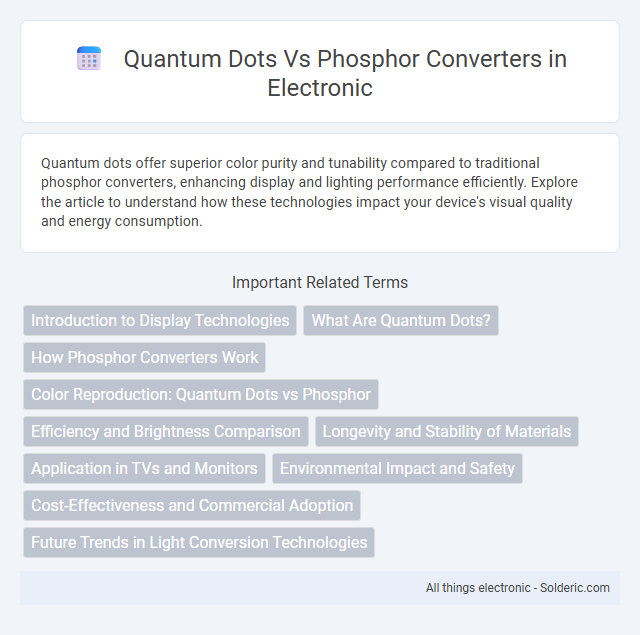Quantum dots offer superior color purity and tunability compared to traditional phosphor converters, enhancing display and lighting performance efficiently. Explore the article to understand how these technologies impact your device's visual quality and energy consumption.
Comparison Table
| Feature | Quantum Dots | Phosphor Converters |
|---|---|---|
| Light Emission | Narrow, tunable emission spectrum | Broad emission spectrum |
| Color Purity | High color purity and saturation | Lower color purity compared to quantum dots |
| Efficiency | Higher luminous efficiency | Generally lower efficiency |
| Stability | Moderate, sensitive to environment | High thermal and chemical stability |
| Applications | Displays, LEDs, solar cells | Lighting, LEDs, display backlights |
| Cost | Higher production cost | Lower production cost |
Introduction to Display Technologies
Quantum dots provide precise color tuning and higher brightness by emitting specific wavelengths when illuminated, enhancing display color accuracy and energy efficiency. Phosphor converters, commonly used in LED displays, rely on phosphorescent materials to convert blue or UV light into broader color spectrums but often sacrifice color purity. Understanding the benefits of quantum dots versus phosphor converters helps you select display technologies that optimize visual performance and energy consumption.
What Are Quantum Dots?
Quantum dots are nanoscale semiconductor particles that emit precise wavelengths of light when excited, enabling superior color accuracy and brightness in displays. Compared to traditional phosphor converters, quantum dots offer enhanced energy efficiency and longer lifespan, making them ideal for next-generation LED and LCD technologies. Your choice of display technology can benefit from quantum dots' ability to deliver vibrant visuals with reduced power consumption.
How Phosphor Converters Work
Phosphor converters function by absorbing high-energy photons, typically from blue or ultraviolet light sources, and re-emitting lower-energy visible light through a photoluminescent process. This energy conversion relies on the unique electronic structure of phosphor materials, where the absorbed photons excite electrons to higher energy states that release light upon returning to their ground state. The efficiency and color quality of phosphor converters depend on the composition and crystal structure of the phosphor, directly influencing applications in LED lighting and display technologies.
Color Reproduction: Quantum Dots vs Phosphor
Quantum dots offer superior color reproduction compared to phosphor converters due to their narrow emission spectra and tunable wavelengths, enabling more precise and vibrant colors. Phosphor converters typically produce broader spectral output, which can result in less saturated and less accurate colors. The enhanced color gamut of quantum dots makes them ideal for high-definition displays requiring vivid and true-to-life color performance.
Efficiency and Brightness Comparison
Quantum dots exhibit higher efficiency and brightness compared to traditional phosphor converters due to their narrow emission spectra and tunable wavelength properties, resulting in more vibrant and energy-efficient light output. Phosphor converters typically face energy losses through non-radiative recombination and have broader emission spectra, which can reduce overall brightness and color purity. Advances in quantum dot materials have led to improved quantum yield and stability, further enhancing their performance in display and lighting applications.
Longevity and Stability of Materials
Quantum dots exhibit superior longevity and stability compared to traditional phosphor converters due to their nano-sized crystalline structure, which resists degradation from prolonged exposure to light and heat. Phosphor converters tend to suffer from thermal quenching and photobleaching, reducing their efficiency over time, especially in high-power LED applications. Your display or lighting system benefits from quantum dots' enhanced durability and consistent performance, ensuring longer operational lifespan and color stability.
Application in TVs and Monitors
Quantum dots enhance TV and monitor displays by delivering brighter colors and improved energy efficiency compared to traditional phosphor converters. Phosphor converters, commonly used in LED backlighting, provide reliable color conversion but often lack the precise color accuracy and wider gamut achievable with quantum dot technology. Your viewing experience benefits from quantum dots' ability to produce more vibrant, lifelike images, making them increasingly popular in advanced display applications.
Environmental Impact and Safety
Quantum dots have a lower environmental impact due to their high efficiency and reduced hazardous material usage compared to phosphor converters, which often contain rare earth elements and heavy metals. Your choice of quantum dot technology can contribute to safer disposal and reduced toxin release, minimizing ecological damage. Safety concerns around quantum dots mainly focus on their nano-scale toxicity, but advancements in encapsulation are limiting exposure risks.
Cost-Effectiveness and Commercial Adoption
Quantum dots offer precise color tuning and higher efficiency but come with higher production costs compared to traditional phosphor converters. Phosphor converters remain the cost-effective choice widely adopted in commercial LED applications due to their established manufacturing processes and durability. Your decision should weigh the premium performance of quantum dots against the proven affordability and scalability of phosphor technology.
Future Trends in Light Conversion Technologies
Quantum Dots exhibit superior color purity and energy efficiency compared to traditional Phosphor Converters, driving their adoption in next-generation display and lighting technologies. Innovations in quantum dot synthesis and encapsulation are enhancing stability and scalability, positioning them as key players in future light conversion solutions. Your choice of light conversion technology will increasingly benefit from these advancements, delivering improved performance and sustainability.
Quantum Dots vs Phosphor Converters Infographic

 solderic.com
solderic.com